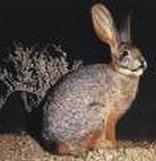The 13th most endangered mammal in the world, the riverine rabbit is South Africa’s second most threatened species after the De Winton’s golden mole. It faces an uncertain future.
The Riverine rabbit is endemic to the central Karoo Desert of South Africa’s Cape Province. It occurs only in dense riverine scrub in the alluvial floodplains of the seasonal rivers in the central Karoo. The normal distribution of this rabbit includes towns like Sutherland,

Riverine Rabbit
Fraserburg and Victoria West.
The Riverine rabbit is easily identified by a distinctive white ring around each eye and a black stripe running from the corner of its mouth over its cheek. The Riverine rabbit weighs up to 1.9 kg. Contrary to what is commonly believed about rabbits, Riverine rabbits breed very slowly. They have a breeding rate of only 1-2 young per year. Births occur during August through to May.
It is the only African rabbit where the female prepares an underground burrow for her young. This nest is lined with grass and fur.
The Riverine rabbit is predominantly a browser eating flowers and leaves from shrubs. Grasses are included in the diet when these are available in the wet season. They are nocturnal, feeding at night and resting during the day.
It is estimated that only a few hundred of these rare animals remain in the wild today and is now listed as critically endangered on the Red List of the International Union for the Conservation of Nature.
The Endangered Wildlife Trust runs a programme to coordinate all conservation efforts on the critically endangered Riverine Rabbit and its habitat.





twice this year I have encountered these guys in Prince Albert, Karoo. I think they were two separate individuals because I saw each of them at the far ends of the town. Hopefully there is some breeding going on.
I visit there fairly often and I would be quite happy to supply any info that might be needed to help get a better picture.